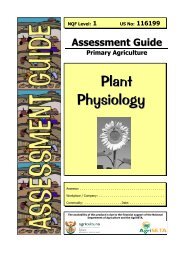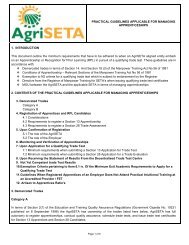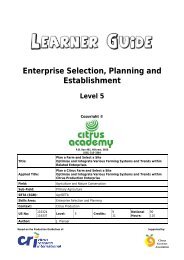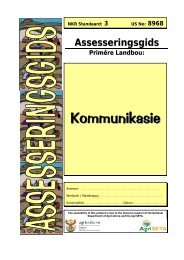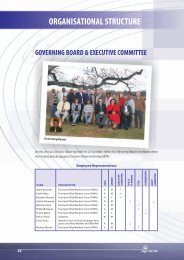Evaluate Basic External Animal Anatomy and Morphology - AgriSETA
Evaluate Basic External Animal Anatomy and Morphology - AgriSETA
Evaluate Basic External Animal Anatomy and Morphology - AgriSETA
- No tags were found...
Create successful ePaper yourself
Turn your PDF publications into a flip-book with our unique Google optimized e-Paper software.
<strong>Evaluate</strong> <strong>Basic</strong> <strong>External</strong> <strong>Animal</strong> <strong>Anatomy</strong> <strong>and</strong> <strong>Morphology</strong>Primary Agriculture NQF Level 1 Unit St<strong>and</strong>ard No: 11617314The frog can change skin colour from darker to lighter tones (to make itless visible from its enemies <strong>and</strong> prey). The skin is only attached in certainplaces to the underlying muscles (the skin is used as a respiratory organ<strong>and</strong> is rich in blood vessels for the purpose of exchanging oxygen in thewater). Body divisionsThe frog has no neck or tail. A head <strong>and</strong> trunk can be distinguished, butthere is no defined division between the regions.Illustration of a frogheadeyesmouth The headThe following features are found in the roughly triangular head:• The mouthThe mouth is on the anterior (front) end of the head.It is large <strong>and</strong> wide with a row of fine teeth on theupper jaw <strong>and</strong> no teeth on the lower jaw (fine teethhelp to hold the prey before it is swallowed). Thetongue is attached in the front <strong>and</strong> on the floor of themouth <strong>and</strong> is loose at the back (the tongue can be unrolled <strong>and</strong> thrownout of the mouth to capture the prey). It is used to capture prey,mostly insects. The prey is swallowed whole.Version: 01 Version Date: July 2006



